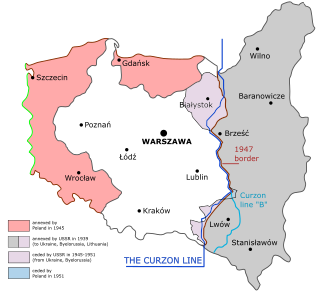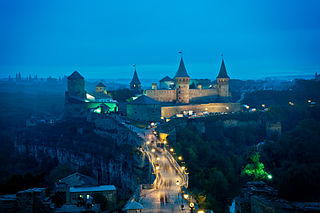
Ruthenia is an exonym, originally used in Medieval Latin as one of several designations for Kievan Rus', Kingdom of Galicia-Volhynia, and, after their collapse, for East Slavic and Eastern Orthodox regions of the Grand Duchy of Lithuania and the Kingdom of Poland, corresponding to what is now Ukraine and Belarus.

The Curzon Line was a proposed demarcation line between the Second Polish Republic and the Soviet Union, two new states emerging after World War I. It was first proposed by The 1st Earl Curzon of Kedleston, the British Foreign Secretary, to the Supreme War Council in 1919 as a diplomatic basis for a future border agreement.
The Poles come from different West Slavic tribes living on territories belonging later to Poland in the early Middle Ages.

Podolia or Podilia is a historic region in Eastern Europe, located in the west-central and south-western parts of Ukraine and in northeastern Moldova. The name derives from Old Slavic po, meaning "by/next to/along" and dol, "valley".

Seventeen days after the German invasion of Poland in 1939, which marked the beginning of the Second World War, the Soviet Union entered the eastern regions of Poland and annexed territories totalling 201,015 square kilometres (77,612 sq mi) with a population of 13,299,000. Inhabitants besides ethnic Poles included Belarusian and Ukrainian major population groups, and also Czechs, Lithuanians, Jews, and other minority groups.

Przemyśl is a city in southeastern Poland with 60,442 inhabitants, as of June 2020. In 1999, it became part of the Subcarpathian Voivodeship; it was previously the capital of Przemyśl Voivodeship.

Galicia or Halychyna is a historical and geographic region spanning what is now southeastern Poland and western Ukraine. The region is named after the medieval city of Halych, and was first mentioned in Hungarian historical chronicles in the year 1206 as Galiciæ. It was part of the mediaeval Kingdom of Galicia and Volhynia. In 1253, Prince Daniel of Galicia was crowned the King of Rus or King of Ruthenia following the Mongol invasion of Kievan Rus'. In 1352, the Kingdom of Poland annexed the Kingdom of Galicia and Volhynia as the Ruthenian Voivodeship. During the partions of Poland, it was incorporated into a crown land of the Austrian Empire — the Kingdom of Galicia and Lodomeria.

Volhynia, is a historic region in Central and Eastern Europe, between south-eastern Poland, south-western Belarus, and western Ukraine. The borders of the region are not clearly defined, but the territory that still carries the name is Volyn Oblast, in western Ukraine. Volhynia has changed hands numerous times throughout history and been divided among competing powers. For centuries it was part of the Polish-Lithuanian Commonwealth. After Russian annexation all of Volhynia was part of the Pale of Settlement designated by Imperial Russia on its southwesternmost border.

Ternopil Oblast, is an oblast (province) of Ukraine. Its administrative center is Ternopil, through which flows the Seret, a tributary of the Dniester. Population: 1,030,562

Volodymyr is a small city located in Volyn Oblast, in north-western Ukraine. It is the administrative centre of the Volodymyr-Volynskyi Raion and the center of Volodymyr hromada. The city is the historic centre of the region of Volhynia and the historic capital of the Principality of Volhynia. It is one of the oldest cities of Ukraine and Kyiv Rus'.

Eastern Borderlands or simply Borderlands was a term coined for the eastern part of the Second Polish Republic during the interwar period (1918–1939). Largely agricultural and extensively multi-ethnic, it amounted to nearly half of the territory of pre-war Poland. Historically situated in the eastern Polish–Lithuanian Commonwealth, following the 18th-century foreign partitions it was annexed by Russia and partly by the Habsburg monarchy (Galicia), and ceded to Poland in 1921 after the Peace of Riga. As a result of the post-World War II border changes, none of the lands remain in Poland today.

The Kingdom of Galicia and Lodomeria, also known as Austrian Galicia or Austrian Poland, was established in 1772 as a crownland of the Habsburg monarchy. It encompassed regions that were acquired by the First Partition of Poland. In 1804 it became a crownland of the newly proclaimed Austrian Empire. From 1867 it was a crownland within the Cisleithanian or Austrian half of the dual monarchy of Austria-Hungary. It maintained a degree of provincial autonomy. Its status remained unchanged until the dissolution of the monarchy in 1918.

Western Ukraine or West Ukraine is the territory of Ukraine linked to the former Kingdom of Galicia–Volhynia, which was part of the Polish–Lithuanian Commonwealth, the Austrian Empire, Austria-Hungary and the Second Polish Republic, and came fully under the control of Moscow only in 1939, following the Molotov–Ribbentrop Pact. The territory includes several historical regions such as Transcarpathia, Halychyna including Pokuttia, most of Volhynia, northern Bukovina, and western Podolia. Less often the Western Ukraine includes areas of eastern Volhynia, Podolia, and small portion of northern Bessarabia.

Galician Jews or Galitzianers (Yiddish:גאַליציאַנערס) are members of the subgroup of Ashkenazi Jews originating in the Kingdom of Galicia and Lodomeria, from contemporary western Ukraine and from south-eastern Poland. Galicia proper, which was inhabited by Ruthenians, Poles and Jews, became a royal province within Austria-Hungary after the Partitions of Poland in the late 18th century. Galician Jews primarily spoke Yiddish.
The Battle of Przemyśl - a struggle for the control over the city of Przemyśl in former Austro-Hungarian Galicia and local river crossings on the San river, between Ukrainian and Polish militias and regular troops, from 2 to 12 November 1918, during the Polish-Ukrainian War.

Bíbrka is a city in western Ukraine, located in Lviv Raion of Lviv Oblast (region) about 29 km southeast of Lviv on H09. It hosts the administration of Bibrka urban hromada, one of the hromadas of Ukraine. The population is approximately 3,810 .

Kozova is an urban-type settlement in Ternopil Raion, Ternopil Oblast (province) of western Ukraine, in the area historically known as Galicia, 16 km (10 mi) east of Berezhany, some 30 km (19 mi) west of Ternopil and c. 100 km (62 mi) southeast of Lviv. It hosts the administration of Kozova settlement hromada, one of the hromadas of Ukraine. The settlement is situated beside a lake on the Koropets River. There is presumption that the name Kozova comes from the Ukrainian word koza (goat), though other possible sources exist. Population: 8,857
Krakovets is an urban-type settlement in Yavoriv Raion, Lviv Oblast, in western Ukraine. It lies on the Polish-Ukrainian border, roughly half way between Lviv in Ukraine and Kraków in Poland on the European route E40, hosting the Korczowa-Krakovets border crossing. The population was estimated at 1,147 .
With the arrival of the Hungarians into the heart of the Central European Plain around 899, Slavic tribes of Vistulans, White Croats, and Lendians found themselves under Hungarian rule. In 955 those areas north of the Carpathian Mountains constituted an autonomous part of the Duchy of Bohemia and remained so until around 972, when the first Polish territorial claims began to emerge. This area was mentioned in 981, when Vladimir the Great of Kievan Rus' claimed the area on his westward way. In the 11th century the area belonged to Poland, then reverted to Kievan Rus'. However, at the end of the 12th century the Hungarian claims to the principality turned up. Finally Casimir III of Poland annexed it in 1340–1349. Low Germans from Prussia and Middle Germany settled parts of northern and western Galicia from the 13th to 18th centuries, although the vast majority of the historic province remained independent from German and Austrian rule.

The Bukovina District, also known as the Chernivtsi District, was an administrative-territorial unit of the Kingdom of Galicia and Lodomeria within the Habsburg Monarchy in Bukovina, annexed from Moldavia. It was first a military district from 1775 to 1786 until it was officially incorporated into Galicia and Lodomeria as its own district.